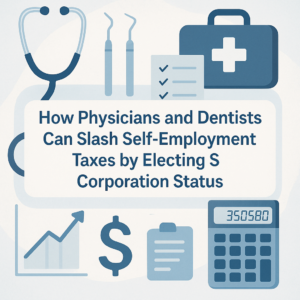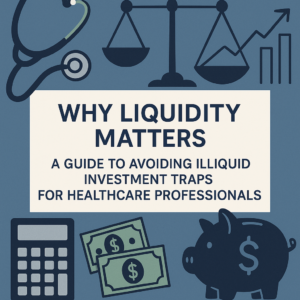As a young healthcare professional—whether you’re a physician, dentist, pharmacist, physical therapist, or psychologist—you’ve dedicated years to mastering your field. Now, as you build your career and start earning a significant income, it’s time to turn your attention to another critical aspect of your future: investing.
But the investment landscape today is markedly different from the one that existed a decade ago. The U.S. stock market has enjoyed a period of remarkable returns over the past ten years, driven by unique economic factors that may not repeat in the coming years. Understanding these changes is crucial for making informed investment decisions that align with your financial goals.
In this comprehensive guide, we’ll explore why replicating the past decade’s stock performance might be challenging, what this means for your investment strategy, and how you can navigate the current economic landscape to build wealth responsibly.
The Exceptional Decade: What Drove Past Stock Returns?
Over the past ten years, the U.S. stock market experienced significant growth, delivering impressive returns for investors. Several key factors contributed to this exceptional performance:
- High Real Earnings Growth: Companies saw substantial increases in earnings after adjusting for inflation. This growth was fueled by technological advancements, globalization, and efficient business practices.
- Increasing Valuations: Investors were willing to pay more for each dollar of earnings, leading to higher stock prices. This willingness was reflected in rising valuation metrics like the Cyclically Adjusted Price-to-Earnings (CAPE) ratio.
- Negative Real Interest Rates: The Federal Reserve maintained low-interest rates to stimulate the economy. Negative real interest rates (interest rates below the inflation rate) made borrowing cheap and encouraged investment in higher-risk assets like stocks.
- CAPE Ratio Expansion: The CAPE ratio expanded significantly, indicating that stocks were valued higher relative to their long-term earnings. This expansion was driven by investor optimism and accommodative monetary policies.
These conditions created a fertile environment for strong stock market returns. However, as with all economic cycles, these trends are subject to change.
Today’s Economic Landscape: Shifting Dynamics
Rising Real Interest Rates
- Increased Federal Funds Rates: The Federal Reserve has raised interest rates to combat inflation, leading to real cash returns of around 2%. This shift contrasts with the negative real cash returns experienced in previous years.
- Impact on Investments: Higher interest rates make bonds and savings accounts more attractive, potentially drawing funds away from the stock market. They also increase borrowing costs for companies, which can slow down earnings growth.
High Valuations and CAPE Ratio Concerns
- Elevated CAPE Ratios: The CAPE ratio remains historically high. To replicate past stock returns, valuations would need to rise to unprecedented levels, which may not be sustainable.
- Risk of Overvaluation: Investing at high valuation levels can lead to lower future returns, especially if valuations revert to historical averages.
Modest Dividend Yields and Earnings Growth
- Lower Dividend Yields: With average dividend yields at about 1.5%, investors receive less income from dividends compared to historical norms.
- Real Earnings Growth Prospects: While earnings may continue to grow, expecting growth rates similar to the exceptional past decade is optimistic given current economic conditions.
Inflation and Monetary Policy
- Persistent Inflation: Inflation erodes purchasing power and can lead to higher interest rates as central banks respond.
- Tighter Monetary Policies: Efforts to control inflation may result in reduced liquidity and slower economic growth, impacting stock market performance.
Implications for Young Healthcare Professionals
Adjusting Return Expectations
- Realistic Projections: Acknowledge that future stock returns may be lower than those experienced in the past decade. Adjust your financial plans accordingly to avoid shortfalls.
- Long-Term Perspective: Focus on long-term growth rather than short-term gains. Investing is a marathon, not a sprint.
Diversifying Your Portfolio
- Asset Allocation: Diversify investments across different asset classes, such as stocks, bonds, real estate, and international markets, to reduce risk.
- Alternative Investments: Consider including alternative investments like REITs (Real Estate Investment Trusts) or commodities, which may perform differently from traditional stocks and bonds.
Enhancing Savings and Investment Rates
- Increase Contributions: Boost the amount you save and invest to compensate for potentially lower returns.
- Automate Savings: Set up automatic transfers to investment accounts to ensure consistent contributions.
Risk Management
- Assess Risk Tolerance: Evaluate how much risk you’re comfortable taking. Factors include your investment time horizon, financial goals, and personal comfort with market fluctuations.
- Rebalance Regularly: Periodically adjust your portfolio to maintain your desired risk level and asset allocation.
Strategies for Navigating the Current Market
Stay Informed and Educated
- Continual Learning: Keep abreast of economic news, financial markets, and investment strategies. Knowledge empowers you to make informed decisions.
- Professional Advice: Consider working with a financial advisor who understands the unique financial situations of healthcare professionals.
Focus on Financial Planning
- Goal Setting: Define clear, achievable financial goals, such as buying a home, funding your children’s education, or retiring comfortably.
- Budgeting: Create a budget that balances your current lifestyle with your savings and investment goals.
Tax-Efficient Investing
- Retirement Accounts: Maximize contributions to tax-advantaged accounts like 401(k)s, 403(b)s, or IRAs.
- Tax Planning: Implement strategies to minimize tax liabilities, such as investing in municipal bonds or utilizing tax-loss harvesting.
Debt Management
- Student Loans: Develop a plan to pay down educational debt efficiently, considering refinancing options or loan forgiveness programs specific to healthcare professionals.
- Avoid High-Interest Debt: Prioritize paying off credit cards or other high-interest debts to improve cash flow and reduce financial stress.
Understanding Investment Vehicles
Stocks
- Equity Ownership: Stocks represent ownership in a company. While they offer growth potential, they also come with higher risk.
- Dividend Stocks: Consider companies that pay dividends, providing a regular income stream in addition to potential stock appreciation.
Bonds
- Fixed Income: Bonds provide regular interest payments and are generally less volatile than stocks.
- Interest Rate Sensitivity: Be aware that bonds can decrease in value when interest rates rise.
Mutual Funds and ETFs
- Diversification: Mutual funds and Exchange-Traded Funds (ETFs) allow you to invest in a basket of securities, spreading risk.
- Cost Considerations: Pay attention to expense ratios and fees that can erode returns over time.
Real Estate
- Property Investment: Real estate can provide rental income and potential appreciation.
- REITs: Investing in REITs offers real estate exposure without the need to manage properties directly.
The Role of Economic Indicators
Understanding key economic indicators can help you anticipate market trends.
Interest Rates
- Federal Reserve Policies: The Fed’s decisions on rates influence borrowing costs, consumer spending, and business investment.
- Investment Impact: Rising rates can lead to lower stock prices but higher yields on savings and fixed-income investments.
Inflation
- Purchasing Power: High inflation decreases the value of money over time, impacting savings and investment returns.
- Inflation-Protected Securities: Consider Treasury Inflation-Protected Securities (TIPS) to safeguard against inflation.
Economic Growth Metrics
- GDP Growth: Gross Domestic Product growth rates indicate the overall health of the economy.
- Employment Data: Employment rates can signal economic strength or weakness, affecting market confidence.
Behavioral Considerations in Investing
Emotions and psychology play significant roles in investment decisions.
Avoiding Emotional Decisions
- Stay Disciplined: Stick to your investment plan even during market volatility.
- Mindfulness: Be aware of biases, such as overconfidence or fear of missing out (FOMO), that can lead to poor decisions.
Market Timing Pitfalls
- Chasing Performance: Avoid switching investments based solely on recent performance.
- Long-Term Commitment: Recognize that time in the market is generally more beneficial than timing the market.
Regular Portfolio Reviews
- Performance Assessment: Periodically review how your investments are performing relative to your goals.
- Adjustments: Make necessary changes based on changes in your personal circumstances, not just market movements.
Leveraging Technology and Resources
Modern tools can simplify investing and financial management.
Investment Platforms
- Online Brokers: Access a wide range of investment options with competitive fees.
- Robo-Advisors: Automated platforms that create and manage portfolios based on your risk profile and goals.
Financial Software
- Budgeting Apps: Track spending, set budgets, and monitor progress toward financial goals.
- Investment Tracking: Use apps to monitor investment performance and asset allocation.
Educational Materials
- Webinars and Workshops: Participate in events focused on financial literacy.
- Professional Organizations: Join groups that offer resources for healthcare professionals interested in finance.
Planning for Retirement
It’s never too early to plan for retirement, especially given the potential for changing investment returns.
Retirement Goals
- Lifestyle Considerations: Envision your desired retirement lifestyle to estimate how much you’ll need.
- Inflation Adjustments: Account for the impact of inflation on future expenses.
Retirement Accounts
- Employer-Sponsored Plans: Maximize contributions to 401(k) or 403(b) plans, especially if your employer offers matching contributions.
- Individual Retirement Accounts (IRAs): Invest in Traditional or Roth IRAs for additional tax-advantaged growth.
Monitoring Progress
- Regular Updates: Review your retirement plan annually to ensure you’re on track.
- Professional Guidance: Consult a retirement planning specialist to refine your strategy.
Protecting Your Financial Future
Safeguarding your income and assets is a critical component of financial planning.
Insurance Needs
- Disability Insurance: Protects your income if you’re unable to work due to illness or injury.
- Life Insurance: Provides financial security for your dependents in the event of your passing.
- Malpractice Insurance: Essential for healthcare professionals to protect against legal claims.
Estate Planning
- Wills and Trusts: Ensure your assets are distributed according to your wishes.
- Healthcare Directives: Specify your preferences for medical care if you’re unable to make decisions.
Conclusion: Empowering Your Financial Journey
Investing in today’s market requires a thoughtful approach, especially with the expectation that future stock returns may not match those of the past decade. As a young healthcare professional, you have the advantage of time and the ability to make informed decisions that can significantly impact your financial well-being.
By:
- Setting realistic return expectations
- Diversifying your investment portfolio
- Embracing prudent financial planning
- Staying informed about economic changes
- Mitigating risks through insurance and professional advice
You position yourself to navigate the uncertainties of the investment landscape effectively.
Remember, the goal isn’t just to accumulate wealth but to achieve financial security that supports your personal and professional aspirations. With a proactive approach and a commitment to ongoing learning, you can build a solid foundation for a prosperous future.
Disclaimer: This article is for informational purposes only and does not constitute financial advice. Please consult with a qualified financial advisor to discuss your specific circumstances before making any investment decisions.






